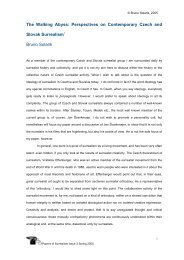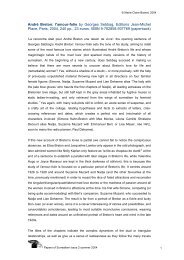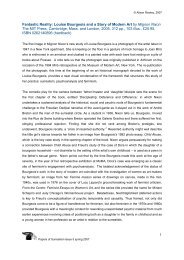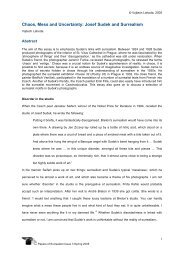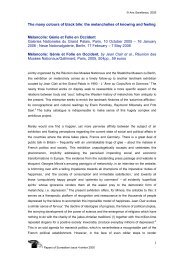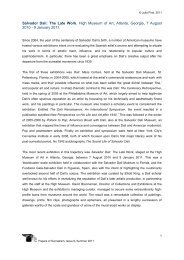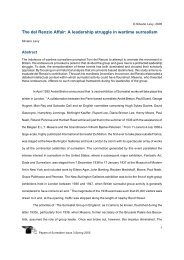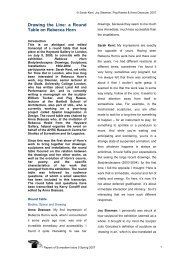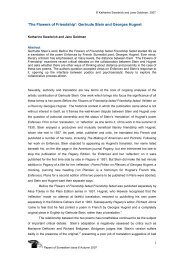From the Walls of Factories to the Poetry of the Street: Inscriptions ...
From the Walls of Factories to the Poetry of the Street: Inscriptions ...
From the Walls of Factories to the Poetry of the Street: Inscriptions ...
Create successful ePaper yourself
Turn your PDF publications into a flip-book with our unique Google optimized e-Paper software.
© Caroline Levitt, 2011<br />
one‟s love<br />
a date<br />
on <strong>the</strong> wall <strong>of</strong> a building,<br />
this vandalism cannot be explained solely by <strong>the</strong> need<br />
for destruction.<br />
I see it ra<strong>the</strong>r as <strong>the</strong> instinct <strong>to</strong> survive<br />
<strong>of</strong> all those who cannot erect<br />
pyramids and ca<strong>the</strong>drals<br />
<strong>to</strong> guard <strong>the</strong>ir names for posterity. 33<br />
Ra<strong>the</strong>r, he suggests, graffiti is a form <strong>of</strong> un<strong>of</strong>ficial, personal, monument, as valid (as Aragon put it<br />
earlier) as <strong>the</strong> inscriptions on obelisks. As a remnant <strong>of</strong> Apollinaire‟s time in <strong>the</strong> trenches, <strong>the</strong><br />
<strong>to</strong>othpaste tin retains his trace for posterity, just as Lili and To<strong>to</strong>r‟s love was immortalised on <strong>the</strong> walls<br />
<strong>of</strong> <strong>the</strong> rue Ber<strong>to</strong>n. Claiming <strong>the</strong> detritus <strong>of</strong> war and fashioning from it new objects lends a sense <strong>of</strong><br />
productive power <strong>to</strong> <strong>the</strong> soldier in <strong>the</strong> trenches, returning him <strong>to</strong> <strong>the</strong> status <strong>of</strong> crea<strong>to</strong>r and individual<br />
ra<strong>the</strong>r than nameless victim. It is Harrow‟s contention that this is one <strong>of</strong> <strong>the</strong> reasons for Apollinaire‟s<br />
continued references <strong>to</strong> <strong>the</strong> minutiae <strong>of</strong> war in his war poetry. 34 The poignancy <strong>of</strong> such traces is akin<br />
<strong>to</strong> that <strong>of</strong> <strong>the</strong> presumably now-executed murderer, „Dédé de Ménilmontant,‟ whose graffiti Apollinaire<br />
reads at La Santé. His mark survives him and becomes monumentalised in Apollinaire‟s writing; <strong>the</strong><br />
insignificant criminal is remembered in <strong>the</strong> same way as heroes.<br />
Monuments <strong>to</strong> <strong>the</strong> insignificant<br />
Julian Stallabrass, in his book Gargantua, comments on <strong>the</strong> relationship between value and<br />
ephemerality as seen in <strong>the</strong> connection <strong>of</strong> contemporary graffiti <strong>to</strong> both advertising and memorial<br />
plaques:<br />
Such writing is a hybrid practice: like companies, graffiti artists and crews take on corporate<br />
identities behind a brand name; like artists, <strong>the</strong>y sign <strong>the</strong>ir works, signing a signature in effect,<br />
and <strong>of</strong>ten date <strong>the</strong>m <strong>to</strong>o, sometimes using Roman Numerals as if on memorial plaques. 35<br />
We are presented with <strong>the</strong> ironic and paradoxical relationship <strong>of</strong> an inherently ephemeral art <strong>to</strong> an<br />
attempt <strong>to</strong> monumentalise and eternalise something by literally „setting it in s<strong>to</strong>ne.‟<br />
The inscriptions that Apollinaire saw in <strong>the</strong> rue Ber<strong>to</strong>n have now been removed, by chipping<br />
away <strong>the</strong> surface <strong>of</strong> <strong>the</strong> s<strong>to</strong>ne-walls. Presumably those responsible were „antiquarians,‟ who<br />
considered <strong>the</strong> etchings <strong>to</strong> be mere graffiti – destructive and inappropriate. However one thing does<br />
remain that Apollinaire noted in 1918: „a marble plaque denoting <strong>the</strong> old boundaries <strong>of</strong> <strong>the</strong> seigneuries<br />
<strong>of</strong> Passy and Auteuil‟ [Fig. 3]. 36<br />
Papers <strong>of</strong> Surrealism, Issue 9, Summer 2011 9





